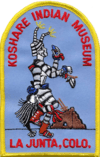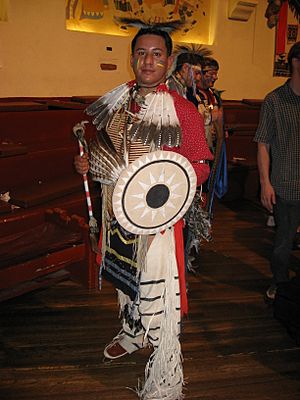Koshare Indian Museum and Dancers facts for kids
 |
The Koshare Indian Museum is a special place in La Junta, Colorado. It's a museum about art and scouting. The building is on the Otero Junior College campus. It has three levels and a unique attached kiva. This kiva has the largest self-supporting log roof in the world! The museum building was finished in 1949.
Inside, you can see amazing art from the Pueblo and Plains tribes.
The museum also helps Boy Scouts who are traveling to Philmont Ranch. They offer discounts to the museum and places for Scout troops to stay.
Some Native American communities have expressed concerns about the Koshare dance performances. They believe it's important to respect the original meaning and traditions of their cultures.
Contents
| Koshare Indian Dancers | |||
|---|---|---|---|

Inside the Koshare Kiva where the Koshare Indian Dancers perform
|
|||
| Headquarters | La Junta, Colorado | ||
| Founded | 1933 | ||
| Founder | James F. "Buck" Burshears | ||
| Affiliation | Boy Scouts of America | ||
|
|
|||
The Koshare Indian Dancers are a group of Boy Scouts from Troop 232. This troop is part of the Rocky Mountain Council of the Boy Scouts of America. They are located in La Junta, Colorado. Since 1933, these Scouts have been performing their own versions of Native American dances.
Besides regular Scouting activities like camping and earning merit badges, the Koshares do something special. They create their own dance outfits, which include leatherwork and beading. They base these outfits on their own historical research. The dancers travel across the country to perform traditional Plains and Pueblo Native American ceremonial dances. They also put on 50 to 60 shows each year. These are called Summer and Winter Ceremonial shows. They perform them at their kiva, which is at the Koshare Indian Museum in La Junta. The Koshares have performed in 47 states.
How the Dancers Started
The Koshare Indian Dancers were founded in February 1933. Their leader was Scoutmaster James F. "Buck" Burshears (1909–1987). He also wrote "The Scoutmaster's Prayer." At first, the group was called the Boy Scout Indian Club. They practiced in Burshears's backyard and even in a chicken coop! Later, their name was changed to Koshare. This word means "clown" or "delight-maker" in the Hopi language. Burshears thought this name fit the early members of the troop well.
The first two Koshare Scouts were Bill Sisson and Bob Inman. They helped Troop 232 grow to include eighteen other Scouts. Their very first performance happened in September 1933. It was at St. Andrew's Episcopal Church in La Junta, Colorado.
One person who saw them perform said:
I have been to many spectacles, from Madison Square Garden and the New Amsterdam Theatre to the Hollywood Bowl and the Santa Anita race track, and there is nothing in my memory to match a performance of these Boy Scouts which was recently given at the Red Rock Theatre, up in the hills from Denver.
A book called Be a Great Boy shares stories from past Koshare Indian Dancers. It also keeps a record of the museum's history and how it has been featured in the media.
Koshare members do more than just regular Boy Scout activities. They spend extra time learning about Native American cultures and ceremonial dances. They also work to recreate Native American clothing and accessories, called regalia. Koshares can move up in ranks within their chosen "tribes." They do this by completing Scouting activities and meeting specific requirements for each rank. The three different tribes whose dance styles are shown are the Kiowa, Sioux, and Navajo.
New members are called Papooses. To join, they must be at least 11 years old. They cannot be older than 18, unless they have earned the Arrow of Light Award. This is the highest award a Cub Scout can get.
After a Scout earns their Star Scout Rank, they can work to become a Koshare Brave. To become a Brave, a Scout must keep good grades in school (a "C" average or higher). They also need to earn the Indian Lore Merit Badge. They must be good at five Koshare Indian dances and show a good Scout attitude. They also read five books about Native American culture. Each Brave creates a well-researched outfit. Finally, they must be chosen by the current Koshare members.
After becoming a Brave, a Scout can become a Clan Chief. There is one Chief for each of the three tribes. To become a Clan Chief, a Scout must first earn their Eagle Scout rank. Also, each year, one Eagle Scout is chosen to be the Head Chief. This person leads all the members.
The Clowns are dancers painted in black and white. They perform between the main dances to add some fun and humor. They might tease the audience or copy the dancers in a funny way. In the Pueblo culture, clowns, or koshare, sometimes help to show what is not good behavior and teach important values.
In 1995, the Koshares wanted to make their dances more accurate. So, they allowed two girls to perform with them each year. This was a success! In 2003, girls were invited to join the performances regularly. This led to the creation of the "maiden program."
75th Anniversary Celebration
On July 25, 2008, the Koshares celebrated their 75th anniversary. They had a big reunion at the kiva. All former members were invited to join the current members for an evening performance. The two original members, Bill Sisson and Bob Inman, were there. Hundreds of current and past members also attended.
Understanding Different Views
It's important to know that different people have different ideas about the Koshare Indian Museum and Dancers. Some Native American historians and community members have shared their thoughts. They believe that when people adopt the traditions and clothing of other cultures, it's important to do so with deep understanding and respect for the original meanings. They feel that sometimes, performances can mix elements from different tribes or not fully capture the true meaning of sacred dances and customs.
For example, in the 1950s, a leader from the Zuni Pueblo saw a performance. He shared his feelings, saying, "We know your hearts are good, but even with good hearts you have done a bad thing." Later, a Zuni community member explained that in Zuni culture, religious objects and practices are only for those who have earned the right to participate. This involves following specific traditions and prayers passed down through many generations.
In May 1972, some Native Americans, including members of the American Indian Movement (AIM), expressed their concerns about a Koshare Dancers event in Topeka, Kansas. They felt it would be better to invite an authentic Native American drum and dance group.
In 2015, the Winter Night dances were canceled. This happened after the Cultural Preservation Office (CPO) of the Hopi Nation asked the troop to stop performing their interpretations of Hopi and Pueblo Native American dances. When Leigh Kuwanwisiwma, the director of the CPO, saw videos of the performances in 2016, he felt they were "insensitive."
As of 2019, the Koshare Dancers have continued their performances. They have not had further discussions with Native American groups. This continues in 2025, as shown by a performance in Bent County, Colorado in April.
See also
- Otero Junior College




